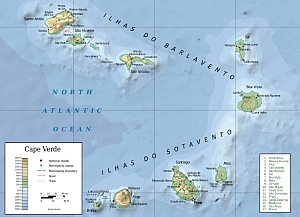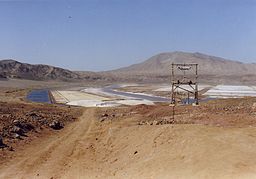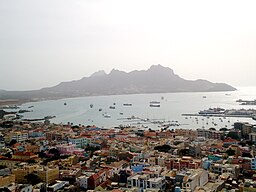
Exploring the history and experiences of mixed heritage persons and inter-racial relationships across the world

Exploring the history and experiences of mixed heritage persons and inter-racial relationships across the world
 Part of the Sahelian arid belt, Cape Verde does not live up it to its verde (means green in Portuguese) name and is officially semi-desert. It does rain irregularly between August and October and is prone to long periods of drought. However, this may not have been the case when Portuguese explorers discovered the "uninhabited" islands in 1456 and followed that with the creation of a settlement called Ribeira Grande in 1462. It is believed that Arab traders may have visited the islands for years prior to settlement to extract salt from naturally occurring salinas and the islands may have been referred to in earlier European literature. Ribeira Grande is regarded as the first permanent European settlement in the tropics. Apart from the ethnic Portuguese settlers, thousands of Jews, regarded branded “undesirables” were exiled to São Tomé and Príncipe, and Cape Verde in and around 1496. Other undesirables such as with vagrants and prostitutes were exiled to the island right up to independence with a camp built for them in Tarrafal in 1949.
Part of the Sahelian arid belt, Cape Verde does not live up it to its verde (means green in Portuguese) name and is officially semi-desert. It does rain irregularly between August and October and is prone to long periods of drought. However, this may not have been the case when Portuguese explorers discovered the "uninhabited" islands in 1456 and followed that with the creation of a settlement called Ribeira Grande in 1462. It is believed that Arab traders may have visited the islands for years prior to settlement to extract salt from naturally occurring salinas and the islands may have been referred to in earlier European literature. Ribeira Grande is regarded as the first permanent European settlement in the tropics. Apart from the ethnic Portuguese settlers, thousands of Jews, regarded branded “undesirables” were exiled to São Tomé and Príncipe, and Cape Verde in and around 1496. Other undesirables such as with vagrants and prostitutes were exiled to the island right up to independence with a camp built for them in Tarrafal in 1949.
 The islands do not appear to have had a major agricultural economy though its position in the Atlantic served as a natural stopping and re-stocking point for shipping despite the limited natural resources. This position helped the economic rise of the islands during the trans-Atlantic slave trade and served them well afterwards until about the 1st World War. As well as being a transit point, many slaves were kept on the islands to provide labour for the sugar and cotton plantations, rum and meat production for ship supplies and as servants to the settlers. In 1580, there were already 14,000 slaves compared to some 2,000 ‘free’ people. The European men, as well as some of the exiled Jews, inter-married or had relationships with slave women creating a mixed race population that continued to grow over the following years. Today, Cape Verde has a population of about 567,000 and just over 70 percent of the population is mixed African and European descent. The remainder of the population is mostly black Africans, with a small number of Europeans.
The islands do not appear to have had a major agricultural economy though its position in the Atlantic served as a natural stopping and re-stocking point for shipping despite the limited natural resources. This position helped the economic rise of the islands during the trans-Atlantic slave trade and served them well afterwards until about the 1st World War. As well as being a transit point, many slaves were kept on the islands to provide labour for the sugar and cotton plantations, rum and meat production for ship supplies and as servants to the settlers. In 1580, there were already 14,000 slaves compared to some 2,000 ‘free’ people. The European men, as well as some of the exiled Jews, inter-married or had relationships with slave women creating a mixed race population that continued to grow over the following years. Today, Cape Verde has a population of about 567,000 and just over 70 percent of the population is mixed African and European descent. The remainder of the population is mostly black Africans, with a small number of Europeans.
It is uncertain whether it was because of the length of time Cape Verde was a colony or the growing acknowledged mixed race population, but Cape Verde was the first Portuguese African colony to have a school for higher education. In vivid contrast to Portugal’s other African colonies, by independence about a quarter of the islands’ population could read and write. This independence movement was, similarly to Angola, led by the educated ‘assimilados’.
To counter the independence movement and nationalism, Portugal changed Cape Verde's status from a colony to an overseas province in 1951 but it can be argued that its response to the infamous droughts that appear to have started or returned in 1747 fuelled the anti-Portuguese sentiment. From then on, a cycle of some 5 years between drought periods decimated the economy with the 16 year drought in 1850 to 1866 resulting in a 3 year famine, 1863 to 1866, that killed a third, some 30,000 people, of the population. The Crown’s response to the suffering on the islands was almost non-existant and landlords, many absentee, continued to attempt to extract harsh land payments from what was, after the abolition of slavery in 1878, peasant workers operating in the sharecropping system. Even fishermen were not exempt from this taxing requirement that meant that 2/3rd of their catch was handed over to the boat owners usually merchants. In all, it is estimated that some 100,000 people died during these drought/famine cycles.
 The declining economic situation at home just before and after independence meant that many Cape Verdeans migrated mainly to Portugal, the USA and other Portuguese held territories such as São Tomé and Príncipe and Angola. However, many who immigrated before independence in 1975 may not show up in the all official figures as the islanders would have been Portuguese passport holders. Many of those of European descent will have joined the other ‘returnees’ from Angola and Mozambique in migrating back to Portugal at independence. It is now accepted that the number of Cape Verdeans and their descendants living abroad currently exceeds the population of Cape Verde itself with some 500,000 in the USA alone. Expatriate Cape Verdeans contribute an amount estimated at about 20% of GDP to the domestic economy through remittances.
The declining economic situation at home just before and after independence meant that many Cape Verdeans migrated mainly to Portugal, the USA and other Portuguese held territories such as São Tomé and Príncipe and Angola. However, many who immigrated before independence in 1975 may not show up in the all official figures as the islanders would have been Portuguese passport holders. Many of those of European descent will have joined the other ‘returnees’ from Angola and Mozambique in migrating back to Portugal at independence. It is now accepted that the number of Cape Verdeans and their descendants living abroad currently exceeds the population of Cape Verde itself with some 500,000 in the USA alone. Expatriate Cape Verdeans contribute an amount estimated at about 20% of GDP to the domestic economy through remittances.
Links